Carpet Beetle Vs. Bed Bug – How To Tell The Difference 2024
Carpet beetle vs. Bed bug, Which is more irritating? I guess your answer is both. But do you know how to identify these bugs? I mean, can you tell the difference between carpet beetle and bed bug when you find some unexpected ‘friends’ in your house?
Unfortunately, you might be confused by these two pests because they appear so similar, but that does not mean you cannot tell them apart.
And if you keep reading, you will not only figure out which carpet beetle or bed bug you have but also discover how to get rid of them like a pro. Let’s find out.

Understanding Carpet Beetle And Bed Bug Through Their Characteristics
It is critical to distinguish between carpet beetles and bed bugs to choose the best strategy to eliminate them.
Apart from the fact that they are both small and have insect-like appearances, they have several differences. Here is the summarized of the comparison between carpet beetle and bed bug for your quick review.
Keep reading for the detailed information regarding these 8 distinct characteristics in the following parts.
Difference in Species
Carpet beetles are the species in Dermestidae gerena with 3 common varieties, which are:
- Varied carpet beetle (scientific name is Anthrenus verbasci)
- Furniture carpet beetle (Anthrenus flavipes)
- Black carpet beetle (Attagenus megatoma)
How do they differ in appearance? The following part will tell you.
In addition, bed bugs belong to the Cimicidae family that also come in different kinds, and those are:
- Common bed bug (Cimex lectularius)
- Tropical bed bug (Cimex hemipterus)
- Bat bug (Leptocimex boueti)
- Mexican chicken bug (Haematosiphon inodorus)
Common and tropical are 2 major bugs that feed on humans. As its name suggests, Bat bugs and Mexican chicken bugs are mainly found on bats and poultry, respectively.
However, it is tough for you to identify which variety of these bed bugs as they all have a similar shape, habitats, or skin bites unless you are an entomologist.
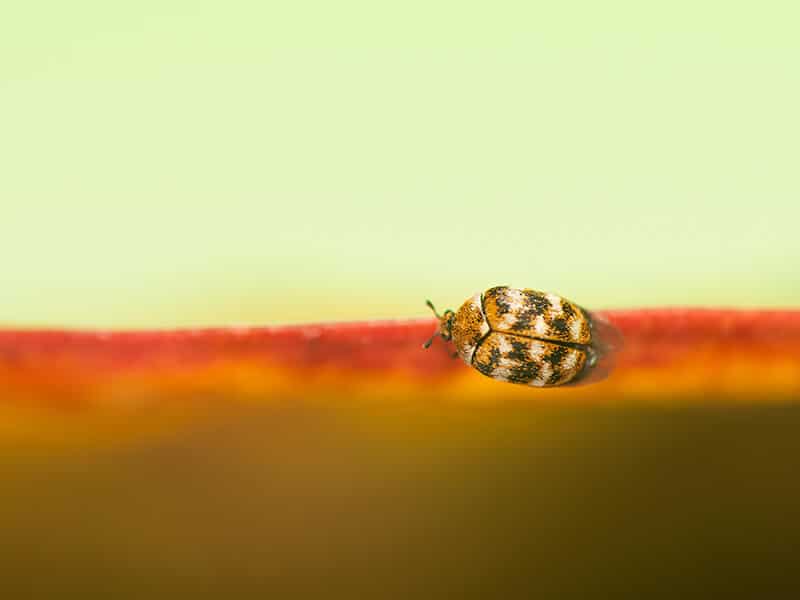
Difference in Life Circle
As these pests come from different species, there are some unlikenesses in life cycles as well.
For carpet beetles, they have 4 life stages as Eggs, Larvae, Pupae, and Adult.
- Eggs: The first stage is laying eggs by female carpet beetles. They usually lay eggs indoors, particularly on the carpet or on any fabric-based surface. It will take around 2 weeks for the eggs to hatch into larvae with the ideal temperature at 24 to 26 C degrees.
- Larvae: Once they grow into this stage, carpet beetles start to feed and develop their size. Full-size larvae can be 0.3 inches long. They also spend around 60 days or more than 1 year in this stage, depending on their types, temperature, or food source.
- Pupae: When larvae hibernate, they will grow their white cocoon, usually in spring, within 6 to 24 days. Moreover, this stage occurs near the food source of these larvae.
- Adult: Adult carpet beetles can only live in a few months though young ones can reach the adult stage within 9 months to 2 years. As their wings are fully developed, they can fly into your house or outside.
For bed bugs, there are 3 primary stages in their life circle, which are Eggs, Nymph, and Adult.
- Eggs: Female bugs can lay up to 10 eggs at one time with pearl-white color. And it might take from 8 to 11 days to hatch.
- Nymph: After hatching, bed bugs come in a tiny size with light yellow color. In fact, this nymph process has 5 stages (aka instar). The whole process might take 5 to 8 weeks before reaching the adult stage.
- Adult: Unlike carpet beetles, adult bed bugs have a longer life span in this stage. They can survive up to 500 days without food. Plus, some laboratory bed bugs can last up to 4 years.
Difference in Appearance
Knowing the size, shape, or other visual features is the easiest way to identify carpet beetles and bed bugs. I also divided this section into 2 stages in their life span as larvae (or nymph) and adult for better comparison.
In Younger Stage (as Larvae Or Nymph)
Different types of carpet beetle have a distinct visual appearance in both early and adult stages, for example:
Varied carpet beetle larvae: Fuzzy, black color and quite bigger than their adult stages.
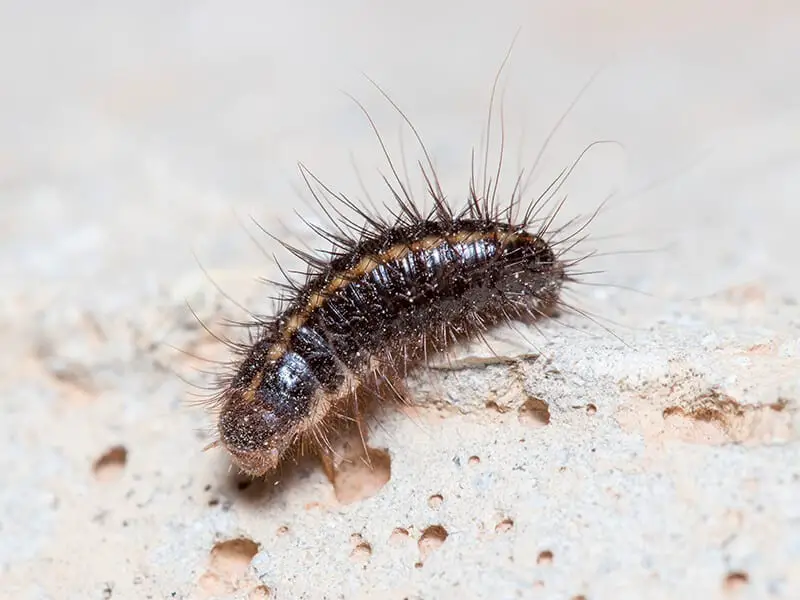
Furniture carpet beetle larvae: The initial color is white but will turn dark brown or red when the larvae mature.
Black carpet beetle larvae: Smooth, shiny, and orange skin with short hair.
In general, the size of young carpet beetles is bigger than the adults, regardless of what type. They also have a hairy look that resembles fuzzy caterpillars.
Wanna know what carpet beetle looks like on your belongings? Let’s check here:
Regarding bed bugs, whether they are common, tropical, bat, or Mexican chicken bugs, the visual look of young and adult bed bugs in these types are essentially the same.
Bed bug larvae, in reality, are called nymphs. They are extremely tiny, like small dots with the size of dust grains or a pin’s tip and in whitish-yellow and translucent color. Plus, these nymphs can grow more significantly in a short time.
In Adult Stage
Alright! Here are closer looks at fully matured carpet beetles and bed bugs. Similarly, adult carpet beetles look varied based on their types, but they look like ladybugs overall.
Adult varied carpet beetles: 0.08 to 0.12 inch (2 to 3 mm) in length with round and tiny shape. They have irregular white, brown, and yellow patterns on their wings, which will start to fade into black or brown as they age.
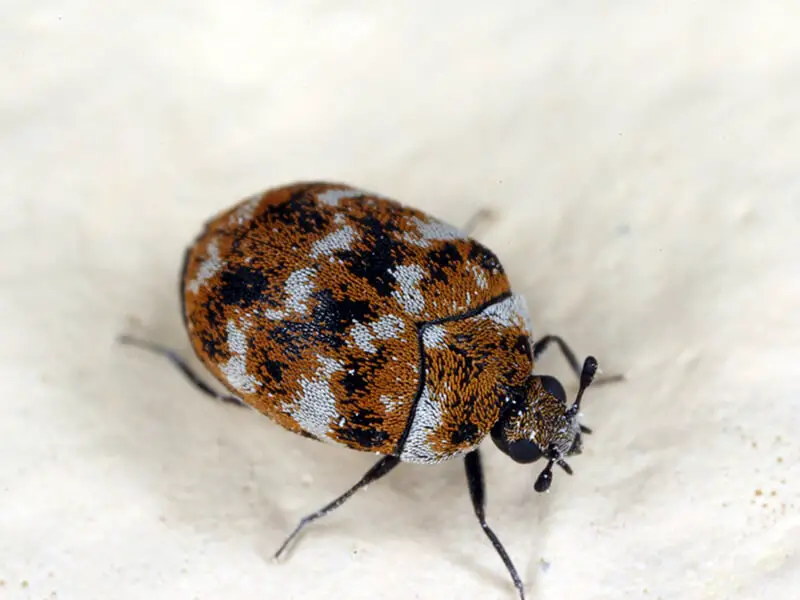
Adult furniture carpet beetles: Around 0.1 inch (2.5 mm) in length with rounder and bigger shape than varied ones. Their wings have dark yellow (or orange) and white scales, which might alter to black with white color underneath.
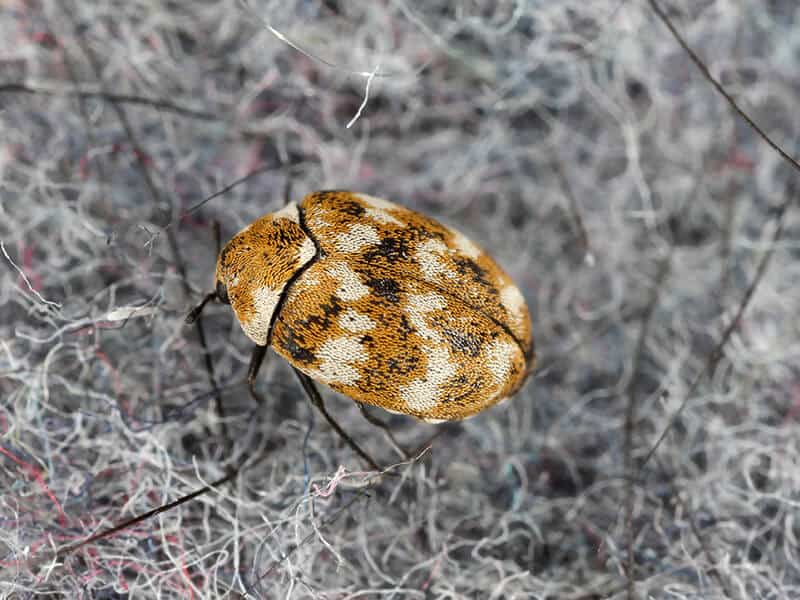
Adult black carpet beetles: 0.12 to 0.2 inches (2 to 5 mm) in length with round and elongate shape. This type is generally bigger than the 2 above types. And like their name, these carpet bugs’ color is black or brown.
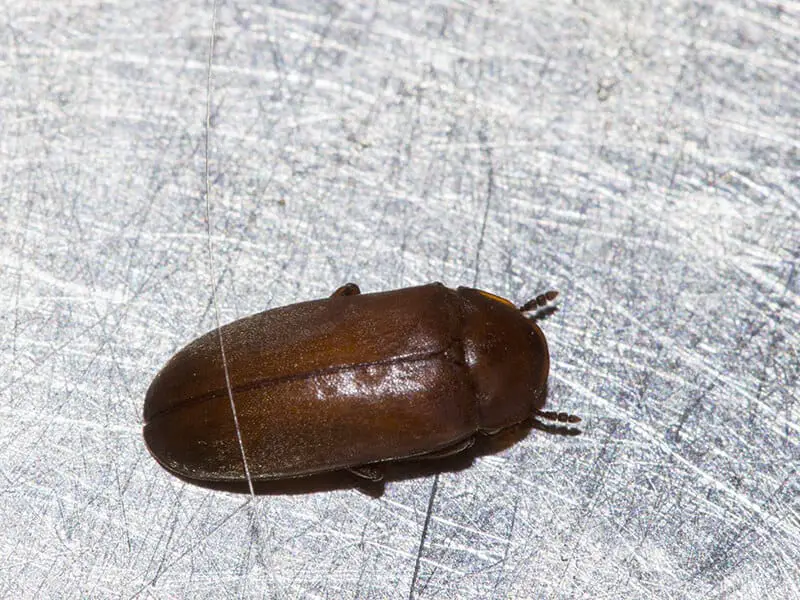
All of these varieties have 2 short antennae, and they can fly. So if you spot the flying insects along with some skin rash on your skin, it is more likely that they are carpet beetles.
Bed bugs, on the other hand, are typically small. Their length is around 0.2 to 0.3 inches (5 to 7 mm) long with an oval, flat, long-shaped body in light brown and semi-translucent color. Bed bug’s head is large, with thick antennae attached. However, they do not possess wings.
To sum up, there are 4 key differences between these 2 pests in terms of appearance that you should note as:
- Size: Carpet beetle sizes are varied based on their varieties but are smaller than bed bugs in general.
- Color: Carpet beetle colors might be brown, yellow, white, orange, or black, whereas the typical colors of bed bugs are light brown or black.
- Body: Carpet beetle is not as flat as bed bugs.
- Other appearance features: Carpet beetles have wings, and they can fly while bed bugs do not. The cut of the head and thorax of carpet beetles are not as recognizable as bed bugs.
If you don’t really care about the specific types of these 2 species, remember that juvenile carpet beetles are larvae, while young bed bugs are not. They have the appearance of adult bed bugs but in much smaller sizes.
Difference in Odor
Another big difference between carpet beetles and bed bugs is the smell. It is not likely that you can sense carpet beetles by a nose as they do not have a specific odor.
In contrast, bed bug infestation in large numbers can result in a strong and musty smell that mimics the odor of a nasty and dirty locker room or an old wet towel. Some people also describe their odor as sweet, musty, or hint of cilantro, rotten wood, cinnamon, or crayons.
Indeed, the odor that bed bugs release is called pheromones. It also depends on the type of these bugs. So if you notice a strange odor coming from your carpet, pillows, mattress, or blankets, bed bugs may have infiltrated your home.
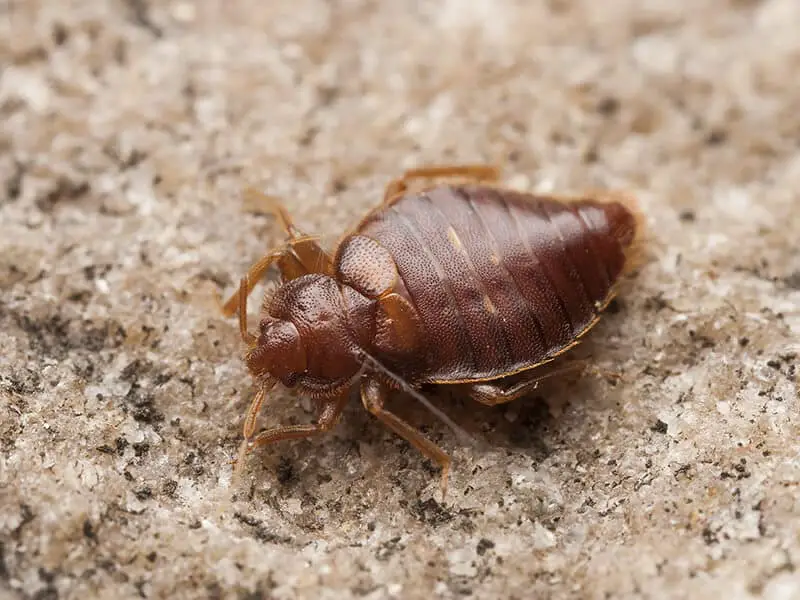
Difference in Habitats
Carpet beetles, unfortunately, are not just simply found in carpets. For example, synthetic carpets are not an ideal habitat for them. Instead, they can be found between/on walls, chimneys, attics, basements, dark places, or anywhere other insects live.
You can also spot them on your bed, closet, furniture, rug, clothes, or even pets’ hair. Once you find some holes on your clothes or shed skin of insects, check these areas immediately as it implies the carpet beetle larvae have infested your home.
Adult carpet beetles can fly into your house through windows or doors so that you might see their appearance near these areas. Their favorite place to lay eggs are furs, leathers, wools, older bedding, and of course, carpets.
As they prefer warmer weather for the breeding process, their infestation in South America is higher than in other American regions.
Nevertheless, it is harder to find the living place of bed bugs than carpet beetles. They have a flat and small body so that they can hide in clothing, mattress, luggage, furniture, dressers, carpet around your bed, or even behind baseboards, walls, cracks, etc.
They tend to live near humans and animals. And they prefer to feed at night when you are sleeping. It might sound so creepy, but bed bugs can live within 6 to 8 feet of where you sleep.
As they cannot fly, they are mainly brought into your home by accident through affected items such as the old mattress you just bought at a low price. Bed bugs can also leave their shed skins, droppings, or blood spots on the infested areas.
Bed bugs can hide anywhere, especially under or on your bed. Watch this video to know more:
Difference in Eating Habits
Another interesting fact about these 2 is regarding their food sources. So, what exactly do they eat?
Carpet beetles’ foods are different based on their life cycle. Adults eat nectar and pollen from plants such as spiraea, crape myrtle, and buckwheat, while larvae devour wool, fur, feathers, cloth, skin, hair, and dead insects, as well as plants and dried meat.
However, in bed bug situations, the situation is even worse. Human blood is their primary source of nutrition. They are also capable of attacking your pets or any other warm-blooded animals.
Depending on their sorts, they will feed every 3 to 1 week. In addition, each feeding takes about 5 to 15 minutes. Bed bugs, like carpet pests, can live for months without eating.
As contrasting eating habits between these insects, their effects on human skin are likewise different. Continue reading to find out.
Here is a closer view of how bed bugs feed on human skin. Watch this video:
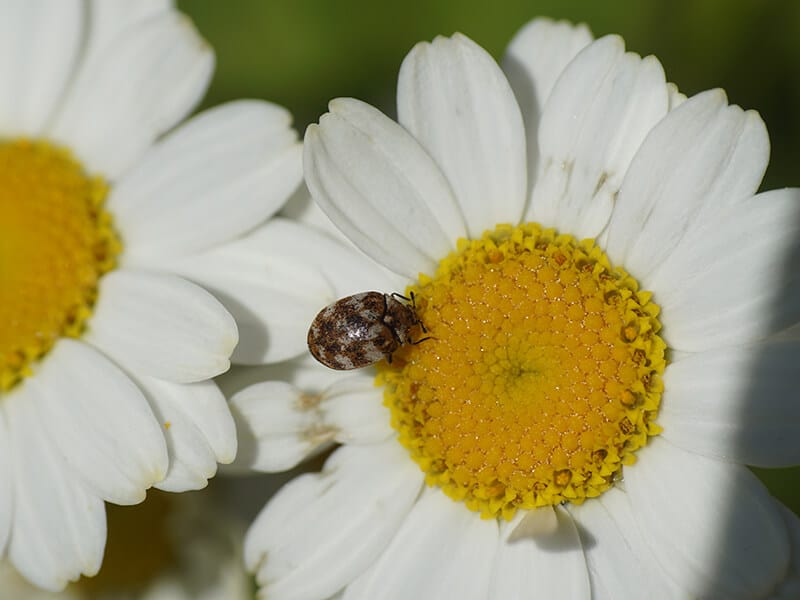
Difference in Bites On Human Skins
Though carpet beetles do not bite people as bed bugs, they still leave a side effect on your skin, especially from carpet beetle larvae.
Once the hair of these larvae’s abdomen touches your skin, it causes a skin rash or red bumps that look like pest bites. In general, carpet beetle dermatitis typically occurs under your clothes and across your body.
However, as bed bugs can bite, their saliva is the reason that makes your skin allergic to red, swelling, and itchy welts. But do you ever wonder why you can barely feel it when they are biting you?
Interestingly, bed bug saliva contains an anesthetic, vasodilator inducer, and anticoagulant, which will act as the pain killer during their feeding. It mainly happens at night from 1 to 5 A.M(1)
As long as you do not scratch these rashes or bites, they will fade away shortly. Otherwise, you might be infected or erupt if you excessively scratch your affected skin. In this situation, please visit your nearest dermatologist for advice or treatment.
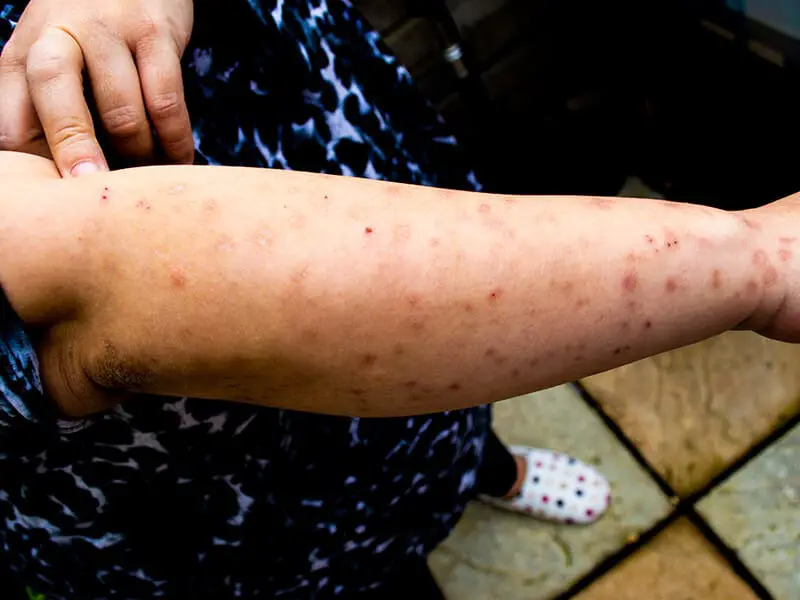
Difference in Risks
As explained in the eating habit section, adult carpet beetles are quite harmless to your life as they usually fly outside to search for nectar and pollen. But the larvae can eat your fabric materials like carpets, rugs, clothes, etc.
Despite the fact that carpet beetle larvae do not tend to move throughout your home, they can nevertheless crawl from place to place or be transmitted by humans (like moving infested clothes to another place).
Besides causing itchy, red blotches on your skin from bed bug bites, they can also leave stains on your bedding or furniture. Worse, the impact of bed bugs on human mental health, such as anxiety or stress, is considerable.
Fortunately, according to the U.S. Environmental Protection Agency, there is no evidence that bed bugs can spread disease (2).
So generally, both of them are dangerous to human lives as carpet beetles can cause allergies, and bed bugs can bite people.
How To Eliminate Carpet Beetles and Bed Bugs?
After learning the differences between 2 pests, it would be better to know how to get rid of them, right? Here are some home remedies that you can implement.
For Carpet Beetles
Carpet beetles can be removed or killed by these tricks, such as:
- Use a vacuum machine: Buying a good bug vacuum cleaner is essential. Use it to vacuum up the infected areas (e.g., carpet, furniture, rugs, curtain, etc.) in case it is not a significant infestatio
- Dry cleaning/heat treating infested items: By using hot water and detergents to remove carpet insects. The best temperature of heat treatment should be higher than 120 F degrees.
- Steam cleaning: There are many effective steam cleaning tips that can assist you in eliminating invisible eggs or beetles by the heat and moisture.
- Use homemade or chemical solutions: White cider vinegar and water can be a great carpet beetle killer. Or, if you need stronger solutions, use boric acid (only work when the bugs eat this chemical) or insecticides.
Though cleaning and sanitizing your areas frequently do not 100% help you get rid of these insects, you can still clean the dust, lint, clothes, etc., to minimize the chance of carpet bugs’ future infestation.
Vacuuming is a great way to eliminate carpet bugs, but remember to clean the canister after using it. Watch this video:
For Bed Bugs
If you spot bed bugs, you should tackle these actions right away as:
- Launder affected items: Like bedding, clothes, etc. Set the water and dryer temperature as high as possible. The ideal temperature is 131 F degrees to kill young and adult bed bugs.
- Check and clean surrounding areas: For example, if you see bugs on your bed, you should also check your bed frames by dismantling them or searching for them on the surrounding carpet.
- Vacuum infested area: Using the best high-performance vacuums for bed bugs to clean. You can replace a vacuum bag with a plastic bag so you can throw it away after using.
- Steam cleaning: Like carpet bug’s case, you can also apply steam clean for your walls, floor, mattress, etc., by a portable machine.
- Use homemade or professional treatments: You can use some home remedies to kill bed bugs. Vinegar, borax, spicy solution, tea tree oil, etc., can be good pest cleaners.
You can also create natural homemade bed bug sprays from green materials to get rid of them. Or buying specialized bug-killer chemicals for better results.
For better instruction on dealing with bed bugs, check here for the answer:
However, if there is a large number of carpet beetles or bed bugs, you should call the expert to have higher-quality treatments or solutions to get rid of them for good.
FAQs
If you still have questions about these dangerous pests, check out the commonly asked questions and brief answers below for more information.
Not Too Hard To Identify Carpet Beetles And Bed Bugs, Right?
At this point, I believe you can distinguish between these pests and treat your belongings and home appropriately. Furthermore, because of their harmful health effects, you should eliminate them as soon as possible before they attack you, your family, or your pets.
Finally, I hope you have gained a better understanding of carpet beetles and bed bugs, as well as how to remove them properly. Please like and share this article with your friends if you find it useful for future reference. Thank you!
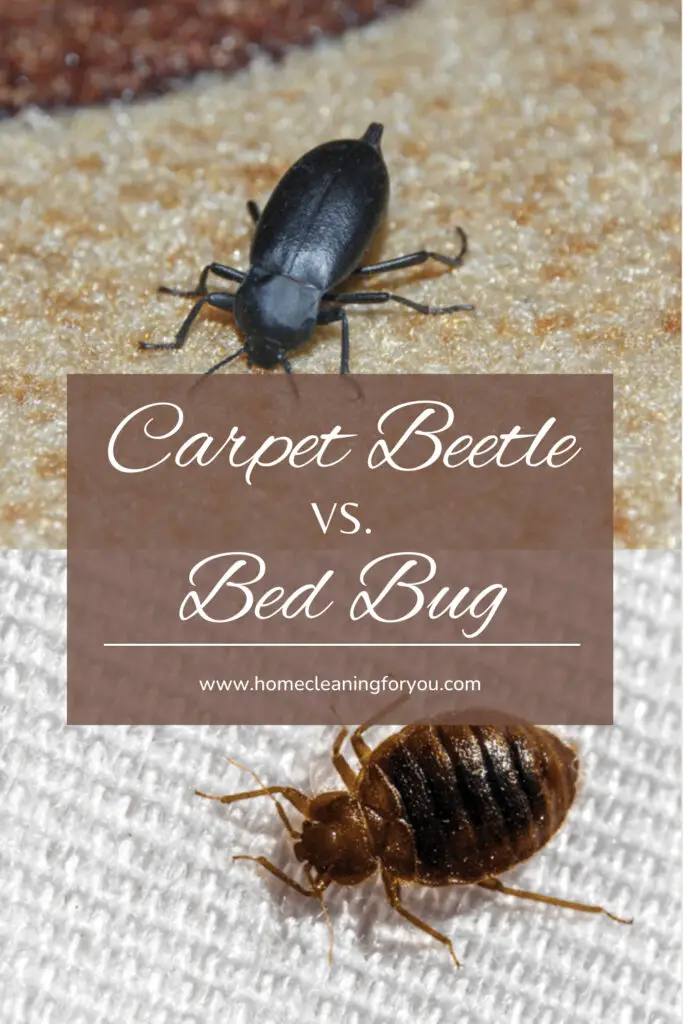
References
1. Doggett, S. L. et al. 2012. ‘Bed Bugs: Clinical Relevance and Control Options’. Clinical microbiology reviews, vol.25(1), pp.164–192. https://doi.org/10.1128/CMR.05015-11.
2. Epa.gov. 2021. Bed Bugs Public Health Issue [Online]. Available at: <https://www.epa.gov/bedbugs/bed-bugs-public-health-issue>.

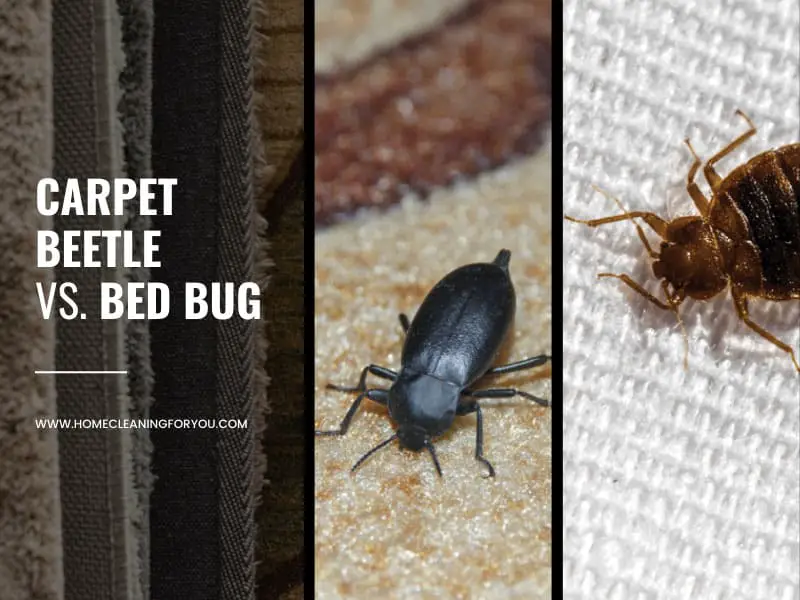






Kevin Jones
Home Cleaning Specialist
Expertise: In-depth Knowledge of Cleaning Agents and Their Uses, Advanced Home Sanitization, Techniques Expertise in Cleaning and Maintaining, Various Floor Types, Innovations in Home Cleaning Tools
School: American College of Home Economics
Kevin Jones is a seasoned home cleaning specialist with over a decade of experience in the industry. A stickler for cleanliness and organization, Kevin brings a systematic and innovative approach to home maintenance. His expertise ranges from traditional methods to modern cleaning technology, ensuring homes are not just clean but healthy environments too.